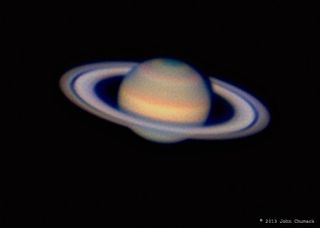Spot the Moon and Saturn Together Tonight!

This evening (Aug. 2) brings another opportunity to identify what many consider to be the most beautiful of all telescopic objects: the ringed planet Saturn. As we have noted previously, as it appears to the naked eye, Saturn does not present any outstanding features. It lacks the dazzling, eye-popping brilliance of Venus or Jupiter, and it does not have the fiery orange-yellow color of Mars.
In fact, to the naked eye, Saturn appears to be nothing more than a very bright "star" that shines with a yellowish-white glow. People looking around the current summertime sky might take note of Saturn while gazing toward the southern part of the sky about an hour after sundown.
But they might be attracted even more to the star Antares, the brightest star in the constellation Scorpius, the Scorpion, which is placed well to the lower right of Saturn. Although it shines only about half as bright as Saturn, Antares is one of the most colorful stars in the sky, shining with a distinct ruddy hue and likely twinkling compared to the steady and sedate Saturn.
Antares' proximity to Saturn can help you identify the planet on most any evening this summer, but tonight another celestial object will pass by the "lord of the rings"— a waxing gibbous moon. [2017 Moon Phases Calendar]
Earth's nearest neighbor in space will be situated about 5 degrees to the upper right of Saturn. If you own a telescope, Wednesday evening will likely be a great night to invite your friends and neighbors over to peer through your eyepiece at these two wonderful night-sky objects.
First, the moon
First, check out the moon. In fact, now is the best time to look at it — not, as many believe, when it is full. A full moon looks "flat" and one dimensional, and its brilliance may dazzle the eye. But tonight's moon is 80 percent sunlit and shines about one-third as bright as a full moon. Check out the region along the terminator, that part of the moon that separates the light zone from the dark zone. Especially in the lower part of lunar disk, you will see many craters casting shadows which will make them stand out dramatically in sharp relief. You won't see these features on a full moon.
And relatively close to the terminator are two of the moon's brightest visible craters. On the lower part of the moon is Tycho, with streaks of brightness radiating out from it in all directions, giving it the appearance of sunflower. And higher up, you'll see another crater with fresh, bright material radiating from it: the so-called "monarch of the moon," Copernicus.
Get the Space.com Newsletter
Breaking space news, the latest updates on rocket launches, skywatching events and more!
Right along the terminator in the moon's upper left portion, you will see a crescent-shaped domain of beauty: Sinus Iridum, the "Bay of Rainbows." This crescent is formed by the Montes Jura (Jura Mountains); here, the highest mountains rise to over 20,000 feet (6,000 meters). This evening, the peaks of this range will catch the light from the rising sun at their tops. This will produce a string of bright points that have been described as the "jeweled scimitar" effect.
And next comes Saturn
After you finish showing off the moon to your friends, it will be time to turn your telescope toward Saturn. Your clenched fist at arm's length is equal to roughly 10 degrees across the night sky. So Saturn will be situated about "half a fist" down and to the left of the moon.
Any telescope with an eyepiece magnifying to at least 30 power will show the planet's famous ring system. Currently, the north face of the rings is tilted almost as far as it can get, an inclination of 26.8 degrees. The outer edge of the rings can be traced completely around the back of the planet, while the front of the rings hides the southern or lower part of Saturn's disk.

And don't be late setting up your telescope to view Saturn and the moon. They'll start sinking toward the southwest fairly soon after twilight and will have set before 2:30 a.m. local daylight time.
A final "gee-whiz" fact you can tell your friends: What you will see in tonight's sky is an illusion of perspective. The moon and Saturn are nowhere near each other in space. The moon will be 251,700 miles (405,000 kilometers) from Earth, while Saturn is 3,333 times farther away, at 869 million miles (1.4 billion km).
Joe Rao serves as an instructor and guest lecturer at New York's Hayden Planetarium. He writes about astronomy for Natural History magazine, the Farmers' Almanac and other publications, and he is also an on-camera meteorologist for Fios1 News in Rye Brook, N.Y. Follow us @Spacedotcom, Facebook and Google+. Original article on Space.com.
Join our Space Forums to keep talking space on the latest missions, night sky and more! And if you have a news tip, correction or comment, let us know at: community@space.com.

Joe Rao is Space.com's skywatching columnist, as well as a veteran meteorologist and eclipse chaser who also serves as an instructor and guest lecturer at New York's Hayden Planetarium. He writes about astronomy for Natural History magazine, the Farmers' Almanac and other publications. Joe is an 8-time Emmy-nominated meteorologist who served the Putnam Valley region of New York for over 21 years. You can find him on Twitter and YouTube tracking lunar and solar eclipses, meteor showers and more. To find out Joe's latest project, visit him on Twitter.
